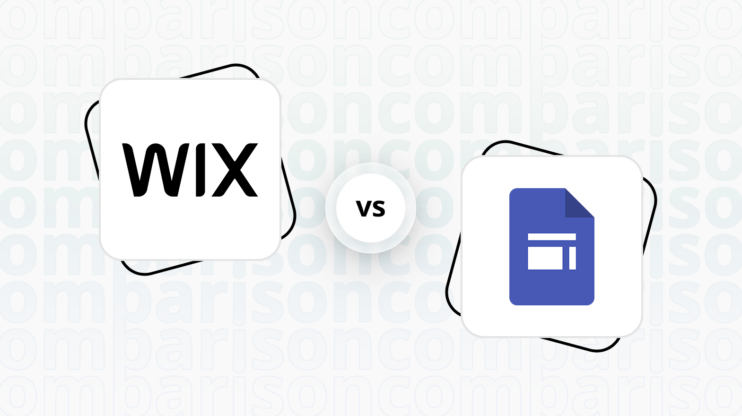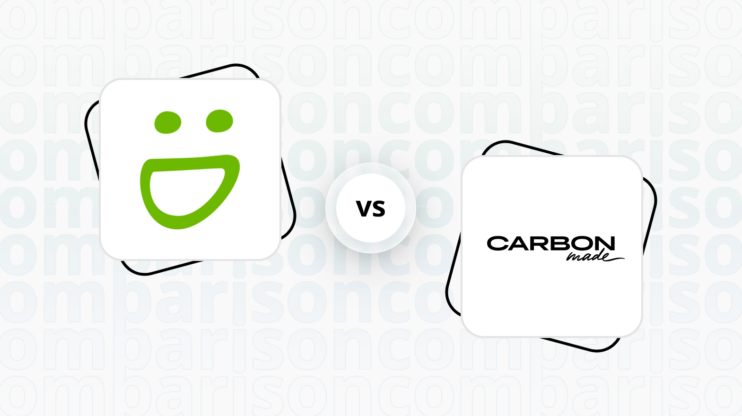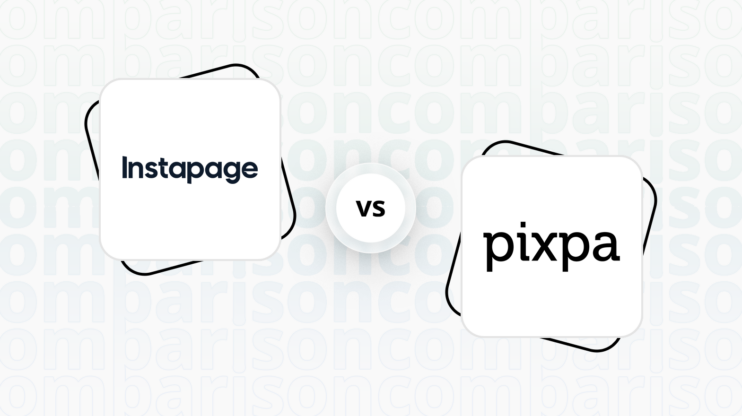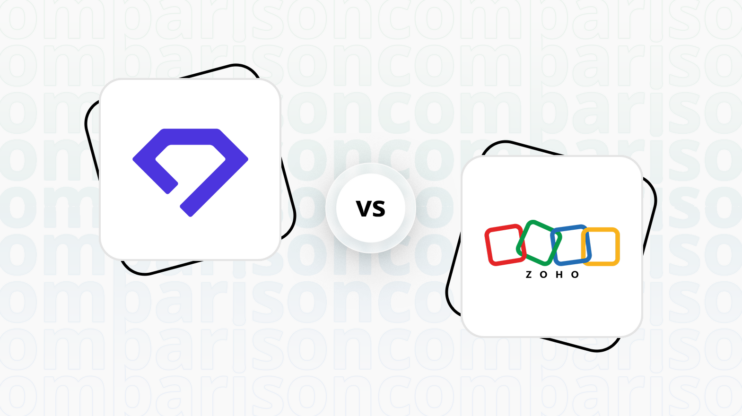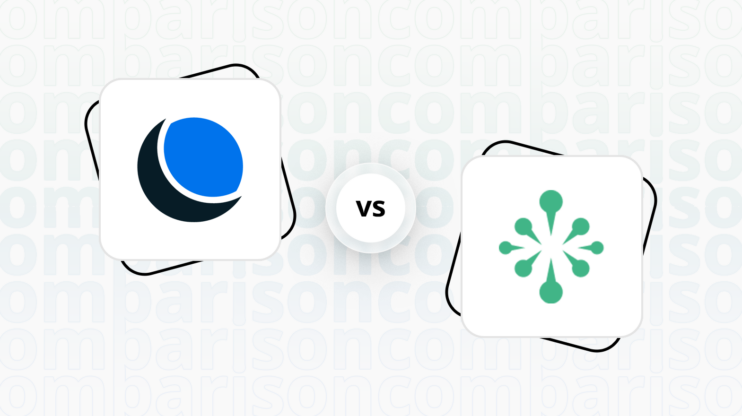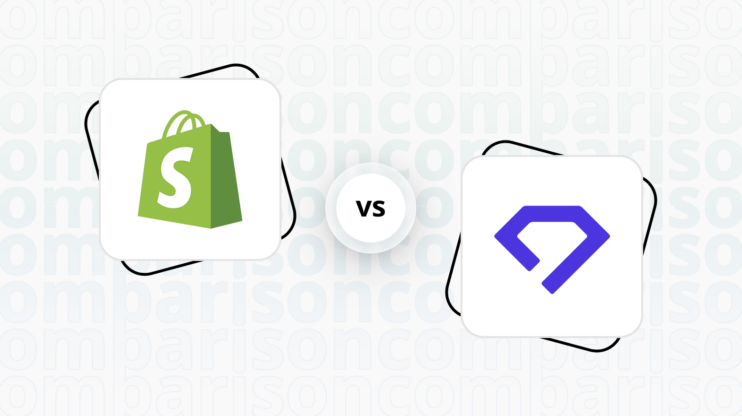Webflow vs Instapage: Final verdict
Webflow and Instapage both offer unique strengths, but they cater to different needs and user bases.
-
Webflow (Overall Grade: 7.9/10)
excels in providing a comprehensive platform for professional designers and developers. It offers powerful design tools, a flexible CMS, and top-tier hosting services. When comparing Webflow vs Instapage, Webflow stands out for its robust design functionalities, extensive customization options, and superior hosting quality, making it ideal for users seeking to create custom, responsive websites without extensive coding knowledge. -
Instapage (Overall Grade: 6.6/10)
is tailored for creating high-converting landing pages with ease. It offers an intuitive drag-and-drop interface, AI content generation, and a range of tools for optimization and personalization. Considering Webflow vs Instapage, Instapage is perfect for marketers and small teams focused on improving advertising conversion rates through targeted landing pages and seamless ad-to-landing-page experiences.

|

|
|
|---|---|---|
|
Design functionalities & templates |
8.6 |
8.0 |
|
Ease of use |
7.5 |
8.5 |
|
Ecommerce |
8.5 |
4.2 |
|
Website Editors |
9.0 |
7.5 |
|
Product testing options |
6.3 |
6.1 |
|
Price |
8.0 |
7.0 |
|
Hosting quality |
8.9 |
6.0 |
|
Website speed optimization |
8.1 |
6.2 |
|
Plugins and integrations |
5.5 |
6.8 |
|
Marketing features |
7.8 |
7.7 |
|
Customer support |
8.3 |
7.6 |
|
Security |
7.8 |
8.4 |
|
AI capabilities |
8.3 |
6.0 |
|
User Management |
8.3 |
7.3 |
Which one is the best for ecommerce: Webflow or Instapage?
 8.5
8.5
 4.2
4.2
Verdict
: Webflow is a more comprehensive solution for ecommerce, offering extensive features and customization options, while Instapage is better suited for creating high-converting landing pages with some ecommerce integrations.
-
Webflow
: Webflow excels in ecommerce with its robust set of features, including checkout and payment processing, marketing tools, and tax and shipping calculations. It offers a variety of ecommerce themes and templates, extensive product page customization, and integration with major payment gateways. With a score of 8.5, Webflow is ideal for businesses looking to build and manage a fully functional online store without extensive coding knowledge. -
Instapage
: Instapage focuses primarily on landing page optimization and ad-to-page personalization, with some ecommerce capabilities through integrations with platforms like Shopify. While it supports payment gateways and offers tools for creating high-converting landing pages, it lacks the comprehensive ecommerce features found in Webflow. With a score of 4.2, Instapage is best for businesses that prioritize landing page performance over full-fledged ecommerce functionality.
Which one is the best for informational and business websites?
 8.6
8.6
 7.9
7.9
Verdict
: Webflow is the superior choice for creating informational and business websites, offering advanced design capabilities and a flexible CMS, while Instapage excels in ease of use and landing page optimization.
-
Webflow
: Webflow is a robust platform designed for professional designers, providing powerful design tools and a flexible CMS. It allows users to build and launch responsive websites without extensive coding knowledge. With a score of 8.6, Webflow stands out for its comprehensive design functionalities and top-tier hosting services, making it ideal for creating custom, responsive informational websites. -
Instapage
: Instapage, scoring 7.9, is tailored for creating high-converting landing pages with ease. It offers an intuitive drag-and-drop interface, AI content generation, and detailed analytics, making it accessible for users with varying technical expertise. While it excels in landing page optimization and team collaboration, it may not offer the same level of design flexibility and customization as Webflow for broader informational website needs.
Webflow vs Instapage: Detailed comparison
Design functionalities & templates
Design FunctionalitiesRepresents how well each platform allows for creative design and customization of websites.Score Components:
- Template Variety (30%): Range and quality of design templates.
- Customization (30%): Flexibility and options for design alterations.
- User Interface (20%): Ease and intuitiveness of the design process.
- Responsiveness (10%): Adaptability to different devices and screen sizes.
- Innovation (10%): Unique design features and tools.
 8.6
8.6
 8.0
8.0
🏆
Winner: Webflow.
If you’re looking for a platform that offers more creative control and a wide array of design features, Webflow is the preferred choice.
Webflow delivers a robust design experience with a diverse range of template and customization options. Boasting over 1000 pre-built templates covering various industries and website types, including free and premium options, Webflow ensures a constantly evolving library for users. Templates are categorized for easy browsing, considering industry, website type, style, and features. The design customization features include a visual drag-and-drop editor for real-time adjustments, fine-grained control over every aspect of the design, and the ability to inject custom code for advanced users seeking additional personalization and unique functionalities.
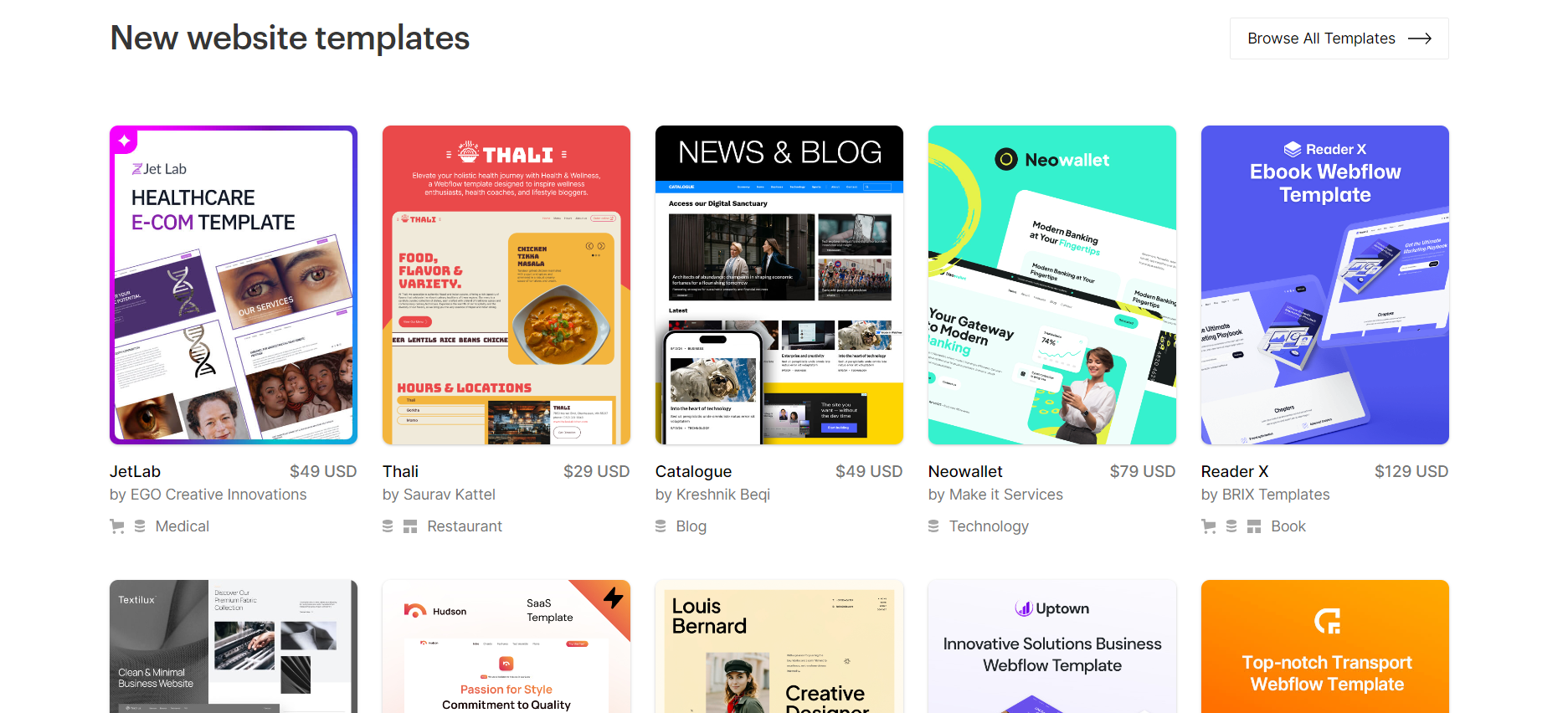
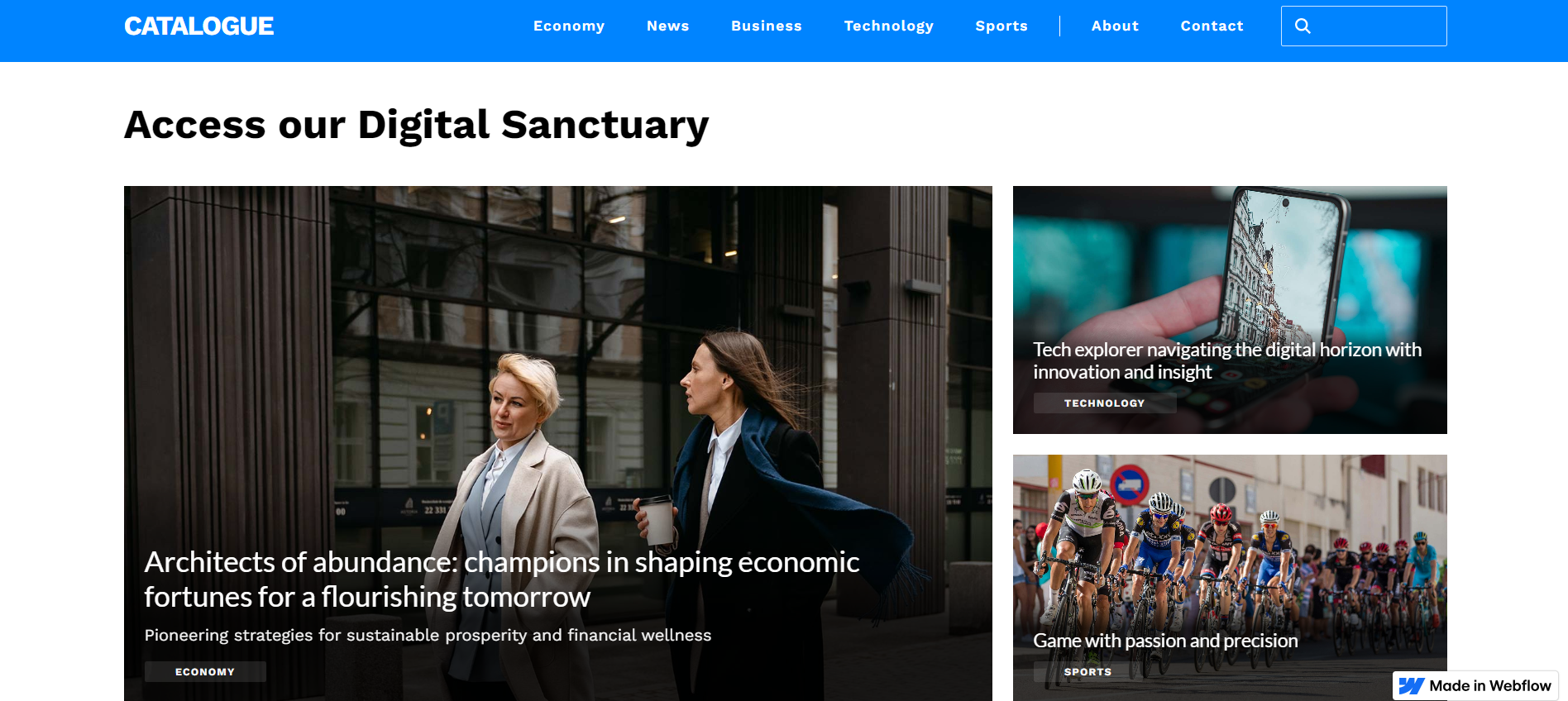
Compared to Webflow, Instapage provides an extensive collection of 100+ design templates for website building, business-specific templates. These templates are tailored to support small teams and businesses in executing their marketing campaigns efficiently, including features for marketing automation, CRM, and analytics integrations.
Get a head start on website creation with AI
Create a custom website tailored to your business needs 10X faster with 10Web AI Website Builder!
Ease of use
Ease of useReflects the platform’s overall user-friendliness.Score
Components:
- Learning curve (40%): Quickness and ease of getting started.
- Interface design (30%): Simplicity and intuitiveness of layout.
- User guidance (20%): Quality of tutorials and support.
- Flexibility (10%): Adaptability to various user skills.
 7.5
7.5
 8.5
8.5
🏆 Winner: Instapage
. With a score of 8.5, Instapage offers an intuitive drag-and-drop interface that simplifies the creation of landing pages, making it accessible to users with various levels of technical expertise. Webflow, scoring 7.5, is user-friendly for experienced designers and developers but may present a steeper learning curve for beginners.
Learning Resources
🏆 Winner: Webflow
. Both platforms offer comprehensive learning resources, but Webflow stands out with its diverse courses and tutorials covering fundamental to advanced aspects of the platform, and a thriving community of over 500,000 members on the official Webflow Forum for discussions and support.
For ecommerce
EcommerceMeasures the platform’s effectiveness in supporting online business activities.Score Components:
- Ecommerce themes and templates (20%): Variety and design of templates.
- Product management (25%): Ease of managing and organizing products.
- Payment options (25%): Variety and convenience of payment methods.
- Ecommerce features (20%): Features for managing an ecommerce store.
- Integration (10%): Compatibility with external e-commerce tools and services.
 8.5
8.5
 4.2
4.2
Webflow and Instapage serve different purposes when it comes to ecommerce. Webflow is a robust platform for creating online stores, offering comprehensive ecommerce features such as easy store creation without coding, extensive customization options, product management with variations, inventory tracking, integration with major payment gateways, automated shipping calculations, tax configuration, and marketing tools like abandoned cart recovery and email marketing. On the other hand, Instapage is primarily focused on building landing pages, however the platform supports integration with ecommerce platforms such as Shopify.

|

|
|
|---|---|---|
|
Ecommerce themes and templates |
7.5 |
0.0 |
|
Product page customization |
8.3 |
0.0 |
|
Payment processing and commissions |
7.8 |
5.0 |
|
POS capabilities |
6.5 |
0.0 |
|
Payment gateways |
8.0 |
6.0 |
|
Product numbers |
7.0 |
0.0 |
|
Additional ecommerce features |
7.9 |
4.0 |
Webflow ecommerce features:
- Checkout and Payment Processing with Stripe, PayPal, etc.
- Marketing and Promotions
- Tax and Shipping calculations
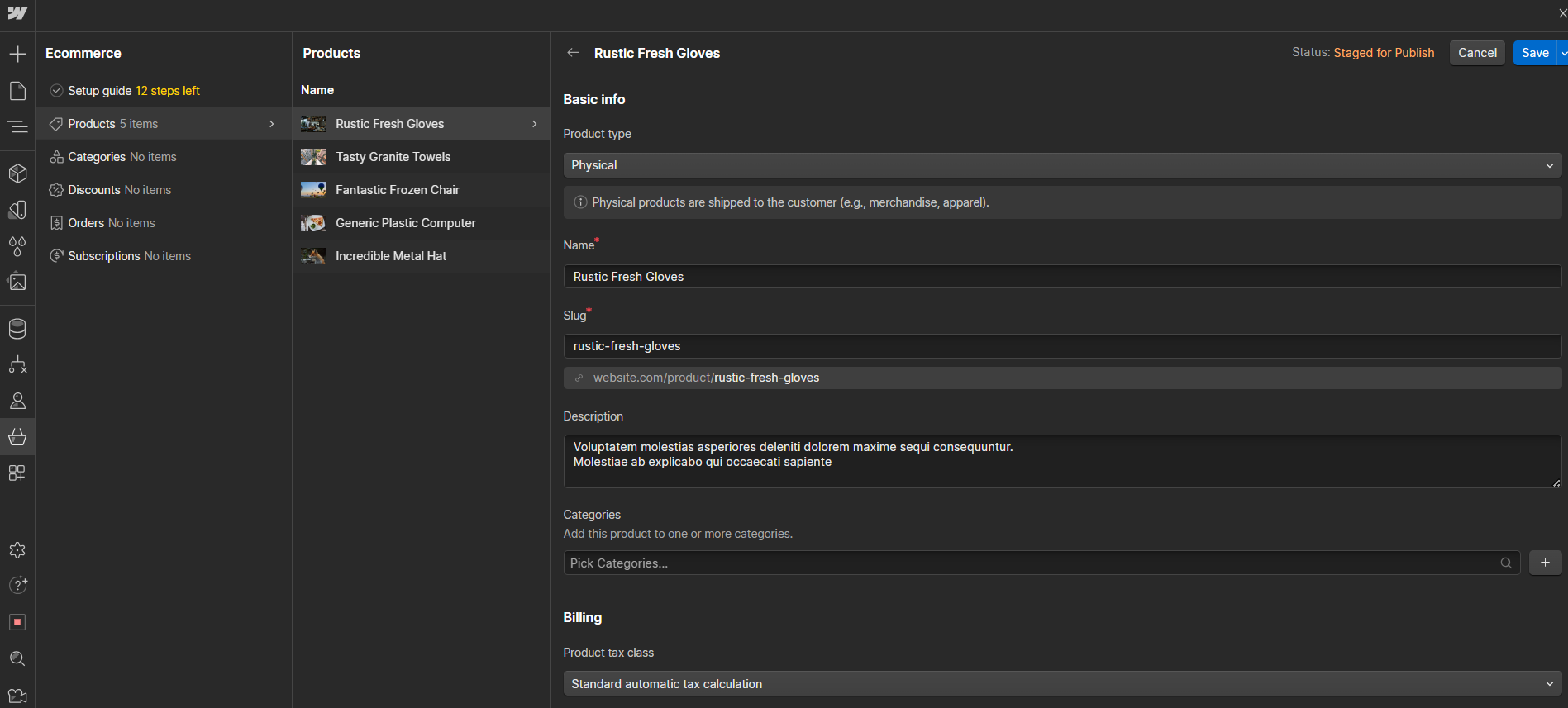
Instapage ecommerce features:
- Shopify integration
- Payment gateways such as Stripe and Paypal
Ecommerce themes & templates
Webflow offers a diverse range of ecommerce themes and templates designed to cater to various types of online stores, from fashion and technology to artisan crafts and children’s products. Each template comes equipped with built-in ecommerce functionality, allowing you to easily add products and manage your store without the need for coding. Instapage, however, does not have ecommerce specific templates.
Product page customization
Webflow offers extensive customization options for eCommerce product pages, allowing users to design and personalize their pages without coding. It provides tutorials for creating product pages from scratch, offers responsive templates for various devices, and allows users to add custom code and dynamic content using Webflow’s CMS for maximum customization flexibility. Instapage does not have product page customization capabilities.
Payment processing
When it comes to payment processing, Webflow provides a flexible and secure platform for payment processing and ecommerce through integrations with leading payment gateways like Stripe and PayPal. This allows users to accept a wide range of payments, including credit card transactions directly from their websites. Instapage supports payment gateway integration, notably through external systems and third-party services like Commence Payments for Stripe, facilitating various payment options such as Apple Pay, Google Pay, and card payments. The platform itself does not directly charge commissions for transactions, but payment gateways may have their own fees. While Instapage specializes in creating high-converting landing pages with a focus on online marketing, it does not explicitly offer Point of Sale (POS) capabilities, suggesting a primary use case away from direct sales or retail transactions.
Website Editors
Website EditorsEvaluates the platforms’ website building and editing capabilities.Score Components:
- Customization tools (40%): Range and power of editing features.
- Editor usability (30%): User experience within the editor.
- Design flexibility (20%): Freedom in layout and design changes.
- Update and maintenance ease (10%): Simplicity of updating and maintaining the site.
 9.0
9.0
 7.5
7.5
🏆
Winner: Webflow
. Webflow, with a score of 9.0, is a cloud-based platform that combines web design, CMS, and hosting, enabling users to visually design responsive websites without writing code. It offers a drag-and-drop interface, integrated SEO tools, ecommerce functionalities, and the ability to add animations and interactions, making web development accessible for designers and powerful for developers. Webflow streamlines the process of web creation, from design to launch, offering both high customization and ease of use.
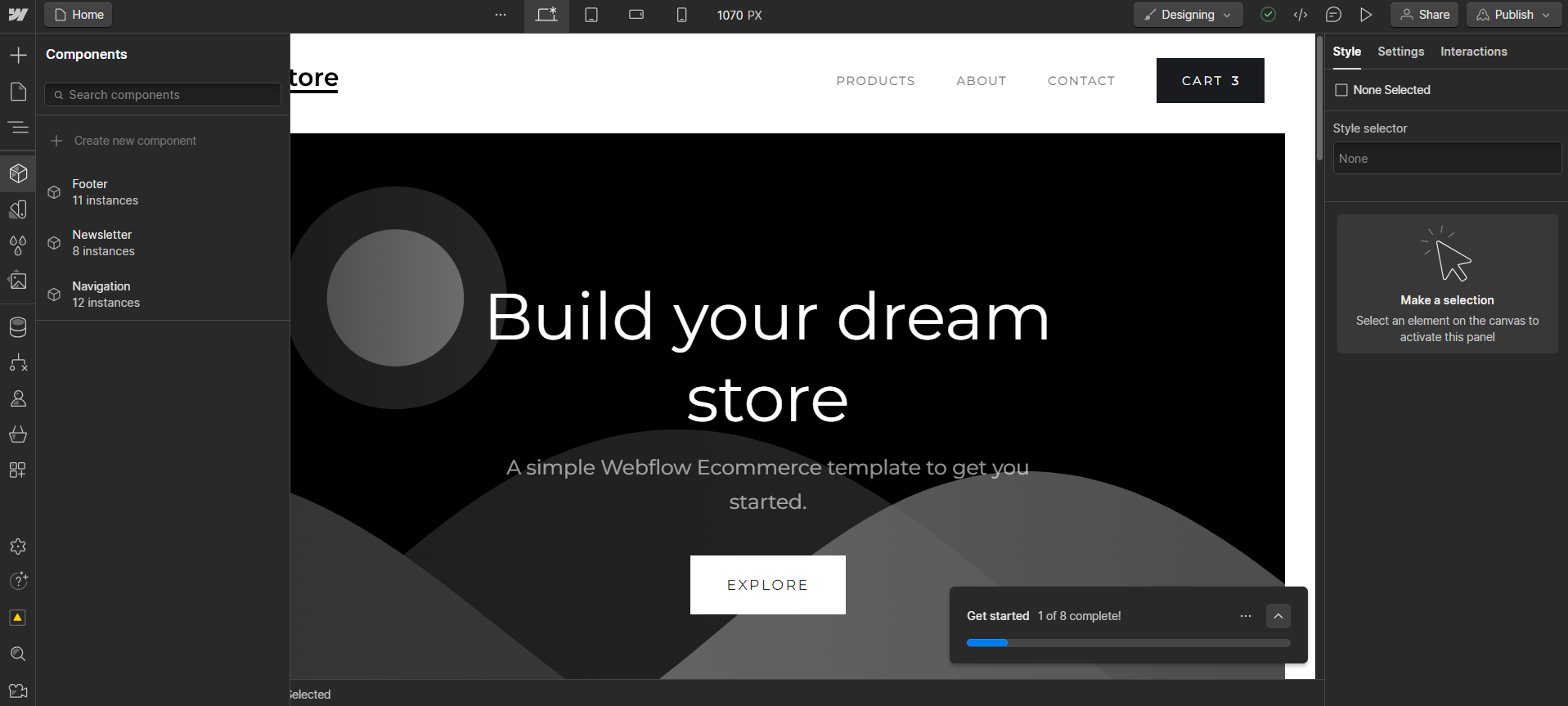
Instapage’s editor, scoring 7.5, is a comprehensive website builder focused on creating and optimizing landing pages for various marketing campaigns. It offers a drag-and-drop editor, AI content generation, detailed analytics, and extensive customization through custom code editing, alongside security and compliance features. The platform supports collaboration, integrates with numerous marketing tools, and is designed to streamline the process of building, testing, and optimizing landing pages to increase conversions.
Mobile editor/app
 7.0
7.0
 0
0
🏆
Winner: Webflow
. When it comes to mobile editing capabilities, Webflow and Instapage both fall short of offering dedicated mobile editor apps. However, Webflow users have access to a third-party app called EditFlow, available for iOS, which provides some mobile editing functionalities. This app, created by a community member, allows users to make on-the-go adjustments to their Webflow sites, albeit with limited features compared to a full-fledged mobile editor.
Instapage, on the other hand, does not offer any mobile editor app, which means users cannot make direct edits to their landing pages from a mobile device. This lack of mobile editing capabilities can be a significant drawback for users who need to make quick changes while away from their desktops.
In summary, while neither platform excels in mobile editing, Webflow edges out Instapage due to the availability of the EditFlow app, providing at least some level of mobile editing capability.
Product testing options
Product Testing OptionsAssesses the options for trying out platform features before commitment.Score Components:
- Trial quality (40%): Extent and usefulness of the trial or free version.
- Feature accessibility (30%): How many features are available to test.
- Trial duration (20%): Length of the trial period.
- Ease of transition (10%): Smoothness of moving from trial to paid plans.
 6.3
6.3
 6.1
6.1
Overall Result
:
Webflow wins
. Webflow scores 6.3, slightly higher than Instapage’s 6.1. Webflow offers a free version with basic features, while Instapage provides a 14-day free trial with access to premium features. However, Instapage requires users to fill in their payment information for the trial, and they may be charged automatically if they don’t cancel by the end of the trial period.

|

|
|
|---|---|---|
|
Free Plan |
Yes | No |
|
Trial Duration |
No | 14 days (with payment information) |
|
Testing Premium Features |
Basic features with free plan | During the free trial |
|
Money Back Guarantee |
No | 24 hours |
Price
PriceLooks at the cost-effectiveness and value for money of each platform.Score Components:
- Plan value (40%): What each pricing tier offers.
- Transparency and clarity (30%): Clearness of pricing structures.
- Flexibility of plans (20%): Range of options to suit different budgets.
- Hidden costs (10%): Additional expenses not included in the plan.
 8.0
8.0
 7.0
7.0
Webflow offers a range of plans, including a free option, and discounts for annual billing. Instapage, on the other hand, has a higher starting price but offers a comprehensive set of features for conversion optimization. Both builders offer customized enterprise solutions.

|

|
|
|---|---|---|
|
Free |
Starter (Free): Limited features for new sites, including 2 static pages and 50 form submissions lifetime. |
No offering at this amount. |
|
$10-$20 |
Basic ($18/month): Suitable for simple sites with a custom domain, including basic SEO controls and 500 monthly form submissions. And 100 pages. Value for Price: 6.5 |
No offering at this amount. |
|
$20-$30 |
CMS ($29/month): For content-driven sites with 2,000 CMS items, 1,000 monthly form submissions, and full API access. And 150 website pages. Value for Price: 7.5 |
No offering at this amount. |
|
$40-$45 |
Standard ($42/month): For new businesses with up to 500 ecommerce items, includes basic ecommerce features, and 2% transaction fee. Value for Price: 8.5 |
No offering at this amount. |
|
$45-$50 |
Business ($49/month): High traffic capacity, advanced features like site search, and up to 10 content editors. Value for Price: 8.0 |
No offering at this amount. |
|
$80-$90 |
Plus ($84/month): Higher volume businesses with 0% transaction fees, up to 5,000 ecommerce items, and advanced features. Value for Price: 9.0 |
No offering at this amount. |
|
$200+ |
Advanced ($235/month): Scalable solution for large online stores with up to 15,000 ecommerce items and the highest caps and 0% transaction fees. Value for Price: 9.5 |
BUILD ($299/month): Optimize conversions with experimentation and lead generation. Includes #1 Landing page builder, No Conversion Limits, Server-Side A/B Testing, AI Content, Unlimited Triggered Popups, Thor Render Engine, Dynamic Text Replacement, SSL Encryption, GDPR Compliance, Google SSO, Zapier, HubSpot, Salesforce, Marketo Integration, Multi-Step Forms, Invisible reCAPTCHA, and more. Value for Price: 7.5 |
location. As a result in rare cases the prices displayed here can differ from the ones you see on their
websites.
Hosting quality
Hosting
qualityExamines the reliability and performance of the hosting solutions.Score Components:
- Uptime (40%): Consistency and reliability of website availability.
- Speed (30%): Loading times and performance.
- Bandwidth and storage (20%): Sufficiency of resources provided.
- Data centers (10%): Quality and distribution of hosting infrastructure.
 8.9
8.9
 6.0
6.0
🏆
Winner: Webflow
Webflow offers managed hosting included in all of their plans, with a 99.99% uptime and an uptime guarantee for the Enterprise plan. They leverage a globally distributed network of data centers from Amazon Web Services (AWS) and Fastly. On the other hand, Instapage offers cloud hosting with a 99.9% uptime and uptime guarantee, but does not disclose the locations of its data centers. Webflow’s transparency and superior uptime give it the edge in this category.

|

|
|
|---|---|---|
|
Do they offer hosting? |
Yes, included in all paid plans |
Yes |
|
Data Centers: |
Webflow doesn’t actually have its own data centers. Instead, it relies on a globally distributed network of data centers from Amazon Web Services (AWS) and Fastly |
Instapage does not disclose the locations of its data centers |
|
Type of hosting: |
Managed Hosting |
Cloud Hosting |
|
Uptime: |
99.99% |
99.9% |
|
Uptime Guarantee: |
Only Enterprise plan, 99.99% |
Yes, 99.9% |
Website Speed Optimization
Website Speed OptimizationEvaluates optimization of website loading timesScore Components:
- PageSpeed Score (30%): Google’s score indicating performance optimization.
- Loading Time (30%): The average time until a website is fully interactive.
- Mobile Optimization (15%): Optimization effectiveness for mobile devices.
- Resource Optimization (15%): Optimizing images, scripts, and other heavy resources.
- CDN Usage (10%): Use of CDN to enhance speed across geolocations.
 8.1
8.1
 6.2
6.2
🏆 Winner: Webflow
Both Webflow and Instapage have their own strategies for optimizing website speed, but Webflow’s comprehensive approach and better performance metrics give it an edge over Instapage.

|

|
|
|---|---|---|
|
Focus |
Custom Cache Settings, CDN |
Responsive design, Image optimization |
|
Performance Tools |
Automatic Minification, Lazy Loading |
Caching |
|
Key Strategies |
Custom Cache Settings, Custom Element Lazy Loading, Automatic Minification, Responsive templates, CDN |
Responsive design, Image optimization, Caching |
|
Load Times |
Below 2 seconds average |
Varies depending on optimization |
|
Page Speed Scores Range |
77.2/100 |
Varies depending on optimization |
|
Core Web Vitals Improvement |
Improving components’ usability, emphasis on LCP, FID, and CLS |
No specific information provided |
Webflow is a responsive website builder, CMS, and hosting platform designed for professional designers. It offers powerful design tools, a flexible CMS, and top-tier hosting services. Webflow’s strategies for speed optimization include custom cache settings, custom element lazy loading, automatic minification, responsive templates, and a CDN. These strategies help Webflow achieve load times below 2 seconds on average and a PageSpeed score of 77.2/100. Additionally, Webflow focuses on improving components’ usability and emphasizes Core Web Vitals (LCP, FID, and CLS).
Instapage, on the other hand, is a landing page platform designed to improve advertising conversion through personalization, optimization, and testing. It offers tools for creating, testing, and optimizing landing pages with a focus on increasing sales, leads, and customer satisfaction. Instapage’s strategies for speed optimization include responsive design, image optimization, and caching. However, Instapage does not provide specific information on their Core Web Vitals improvements, and their load times and PageSpeed scores vary depending on optimization.
Overall, Webflow’s comprehensive approach to speed optimization and better performance metrics make it the winner in this comparison.
Get a head start on website creation with AI
Create a custom website tailored to your business needs 10X faster with 10Web AI Website Builder!
Plugins and integrations
Plugins and integrationsMeasures the range and effectiveness of additional plugins and integrations.Score Components:
- Variety of options (40%): Range of available add-ons.
- Integration smoothness (30%): Ease of integrating plugins into the site.
- Quality of plugins (20%): Functionality and reliability of the options.
- Custom integration capabilities (10%): Support for custom or third-party integrations.
 5.5
5.5
 6.8
6.8
🏆 Winner: Instapage.
With a score of 6.8, Instapage takes the lead in this category. It supports over 40 integrations with third-party platforms, including major CRM, email marketing, analytics, and advertising tools. This allows users to seamlessly connect their landing pages with essential digital marketing tools and services, enhancing the overall marketing funnel. Webflow, scoring 5.5, offers a built-in library of website elements and functionalities and integrates with a number of third-party services and tools. However, it doesn’t have plugins or extensions in the traditional sense, which may limit its extensibility compared to Instapage.
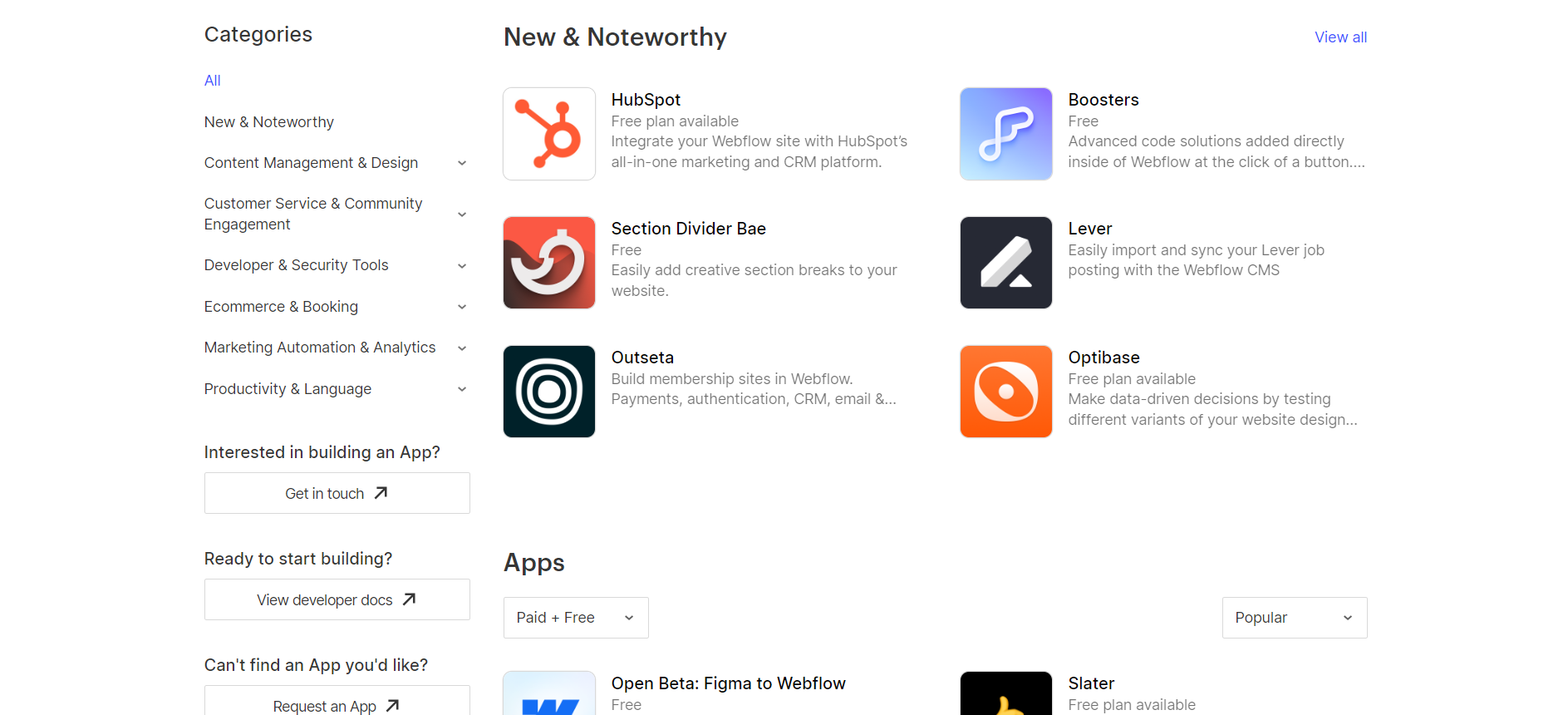
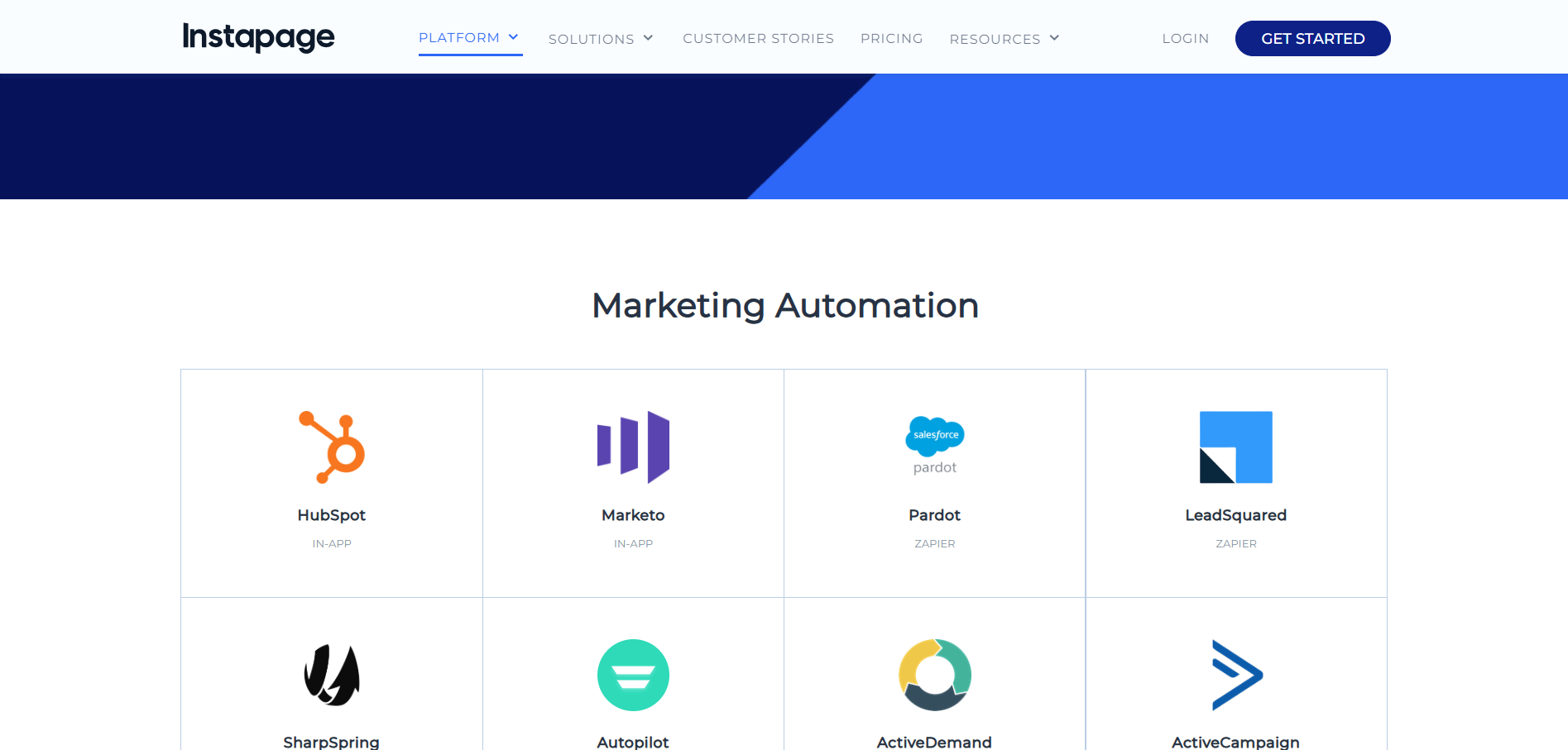
Marketing Features
Design FunctionalitiesRepresents how well each platform allows for creative design and customization of websites.Score Components:
- Template Variety (30%): Range and quality of design templates.
- Customization (30%): Flexibility and options for design alterations.
- User Interface (20%): Ease and intuitiveness of the design process.
- Responsiveness (10%): Adaptability to different devices and screen sizes.
- Innovation (10%): Unique design features and tools.
 7.8
7.8
 7.7
7.7
🏆
Overall Winner: Webflow
. Webflow edges out Instapage with a slightly higher score, offering a comprehensive set of marketing tools including SEO, email marketing, blogging, social media integration, analytics and reporting, and ads and promotions. Instapage, while lacking in blogging, offers a strong suite of features focused on landing page optimization and ad-to-page personalization.

|

|
|
|---|---|---|
|
SEO Tools |
✓ |
✓ |
|
Email Marketing |
✓ |
✓ |
|
Blogging |
✓ |
✗ |
|
Social Media Integration |
Simplifies content sharing and audience engagement on major social platforms |
Yes, with features for tracking and campaign management |
|
Analytics and Reporting |
Integrates with Google Analytics for comprehensive web traffic and behavior analysis |
Yes, including conversion analytics, real-time reports, and A/B testing |
|
Ads and Promotions |
Supports ad and promotion management through integration with platforms like Google Optimize |
Yes, with features like AdMap for ad-to-page personalization and integration with advertising platforms |
Customer Support
Customer supportEvaluates the quality and availability of support options.Score Components:
- Response time (40%): Speed of support responses.
- Support quality (30%): Effectiveness and helpfulness of the support.
- Availability (20%): Range of support channels (phone, chat, email).
- Resource richness (10%): Quality of self-help and educational materials.
 8.3
8.3
 7.6
7.6
🏆 Winner: Webflow
. In the Webflow vs Instapage comparison, Webflow takes the lead with a customer support score of 8.3. Webflow offers 24/7 support through live chat, email, and a community forum, ensuring users can get help at any time. Additionally, Webflow provides extensive documentation and video tutorials, making it easier for users to find solutions independently.
Instapage, with a customer support score of 7.6, offers live chat support from Monday to Friday, 24 hours a day, and technical support via email and phone during regular business hours. While Instapage’s support is robust, it doesn’t match the round-the-clock availability that Webflow provides. However, Instapage is praised for its personalized assistance through Success Managers and Launch Specialists, which is particularly beneficial for enterprise users looking to optimize their conversion rates and ROI.
Security
SecurityLooks at the platforms’ security measures and data protection.Score Components:
- Data protection (40%): Safeguards for user and customer data.
- SSL and encryption (30%): Implementation of secure connections.
- Compliance (20%): Adherence to industry security standards.
- Regular updates (10%): Frequency of security updates and patches.
 7.8
7.8
 8.4
8.4
🏆
Winner: Instapage
. Instapage excels in security with a comprehensive approach that includes SOC 2 Type I and II compliance, GDPR and CCPA alignment, and a robust Information Security Program based on ISO 27001/2 and NIST 800-53 frameworks. These measures ensure a high level of protection for user data and compliance with stringent privacy regulations, making it a reliable choice for users who prioritize security.
Webflow also offers strong security features, such as SSL encryption, regular security audits, and two-factor authentication. These measures provide a solid foundation for protecting user data and maintaining website security. However, with a slightly lower security score compared to Instapage, Webflow may not offer the same level of comprehensive security protocols.
AI Capabilities
AI capabilitiesMeasures the effectiveness of AI-driven features and tools.Score Components:
- Automation efficiency (40%): Impact of AI on streamlining processes.
- Personalization (30%): AI-driven customization for users or customers.
- AI-Assisted design (20%): Role of AI in website design and functionality.
- Data analysis (10%): Use of AI in interpreting user data and analytics.
 8.3
8.3
 6.0
6.0

|

|
|
|---|---|---|
|
AI Builder |
Not available, but announced for future release |
Not available |
|
AI Ecommerce features |
Not available |
Not available |
|
AI content generation |
Not available, but announced for future release |
Available, with automatic content generation for landing pages |
|
Additional AI features |
Announced for future release |
AI Experiments for dynamic traffic allocation to landing pages |
🏆 Winner: Instapage
. Despite the lack of an AI builder, Instapage’s AI capabilities, particularly in content generation and dynamic traffic allocation, provide valuable tools for optimizing landing pages. Webflow, while not currently offering AI capabilities, has announced plans to introduce them in the future, which could potentially enhance its platform significantly.
Webflow, with a score of 8.3, has announced plans to leverage AI to improve the visual development learning journey, create and iterate designs faster with an AI copilot, and offer AI-customized templates for quicker website creation.
Instapage, with a score of 6.0, offers AI content generation and AI experiments for dynamic traffic allocation to landing pages, which can help in improving advertising conversion through personalization, optimization, and testing.
User Management
User ManagementAssesses the platforms’ capabilities in managing user roles, permissions, and accessibility.Score Components:
- Role Customization (40%): Flexibility in creating and defining user roles and
permissions. - Ease of Management (30%): User interface and tools for managing users.
- Access Control (20%): Effectiveness of access control measures for different user
levels. - Scalability (10%): Ability to manage a growing number of users efficiently.
 8.3
8.3
 7.3
7.3
🏆 Winner: Webflow
. Both Webflow and Instapage offer robust user management features, but Webflow stands out with its more comprehensive role-based permissions and collaboration tools.
- Webflow allows for a varying number of users based on the plan, with unlimited editors available in higher-tier plans. It offers detailed role-based permissions, including roles like Designer, Editor, and Admin, ensuring secure and efficient collaboration.
- Instapage provides roles such as Viewer, Editor, and Manager, with the number of users depending on the subscription plan. However, only one user can edit a page at a time to prevent overwrite issues.
Webflow User Roles and Access Levels:
| Role | Description | Access Highlights |
|---|---|---|
| Workspace Owner | Full control over Workspace settings and member management. | Edit settings, manage billing, access/edit all sites, invite/remove members, manage permissions. |
| Workspace Admin | Similar to the owner with some restrictions. | Edit settings, manage billing, access/edit all sites, invite/remove members (except owner), manage permissions. |
| Workspace Member | Limited control focused on site interaction. | Download invoices, access/edit sites, invite members. |
| Workspace Guest | Temporary collaborators with limited access. | Access/edit sites. |
| Workspace Commenter | Limited to commenting for feedback on sites. | Create/view/resolve comments, preview sites. |
| Site Admin | Full control at the site level. | Manage permissions, delete/transfer sites, billing management, design and publish changes. |
| Can Design | Design capabilities with some restrictions on publishing. | Design in Designer, create/modify classes and components, publish changes with permission. |
| Can Design (Limited) | Restricted design capabilities for Enterprise customers. | Create new classes, modify created classes, limited publishing capabilities. |
| Can Edit | Content editing without full design privileges. | Edit text/links/images, manage assets, publish Collection items and Ecommerce products. |
| Can Comment (Site Level) | Commenting for feedback at the site level. | Create/view/resolve comments, preview sites. |
Instapage User Roles and Access Levels:
| Role | Description | Access Highlights |
|---|---|---|
| Administrator | Oversees the entire Instapage account, managing users, settings, and billing information. | Full access to all features, including user management, settings, billing, and page creation and editing. |
| Editor | Works on creating and editing landing pages, responsible for the design and content. | Can create and edit pages, manage integrations, and view analytics, but cannot change account settings or manage users. |
| Viewer | Has view-only access to the landing pages, typically for review or analytics purposes. | Can view pages and analytics but cannot make any edits or access account settings. |
Additional Features

|

|
|
|---|---|---|
|
SSL Certificate |
✓ |
✓ |
|
Custom Domain |
✓ |
✓ |
|
Free Custom Domain Included |
✓ |
X |
|
International Domains |
✓ |
✓ |
|
Mobile Responsive |
✓ |
✓ |
|
Page Speed |
✓ |
✓ |
|
Website Builder Mobile App |
X |
X |
|
Convert a Website To An App |
X |
X |
|
Website Analytics |
✓ |
✓ |
|
Multilingual Sites |
✓ |
✓ |
|
Multiple Users |
✓ |
✓ |
Webflow vs Instapage: User Feedback
Webflow receives high praise for its user-friendly interface, eliminating the need for coding while offering extensive design flexibility. Users appreciate its scalability, cost-effectiveness, and seamless integration of essential features like forms and CMS. However, some users note a slight learning curve and occasional limitations, particularly in ecommerce functionalities and content management. Overall, Webflow proves to be a powerful tool for building and managing websites, offering robust features for both beginners and experienced developers, albeit with some room for improvement in certain areas like collaborative editing and content management.
Users generally appreciate Instapage for its user-friendly interface, robust customer support, and seamless integration capabilities, highlighting its effectiveness in creating high-quality, high-converting landing pages optimized for lead capture. Positive feedback emphasizes the platform’s ease of use, allowing both experienced marketers and newcomers to quickly design and deploy landing pages, along with its broad range of integrations with other marketing tools and CRM systems. However, some users encounter challenges with mobile responsiveness, custom domain settings, and occasional bugs.
The making of this blog
We followed a clear, step-by-step process to write and research this article.
Webflow vs Instapage: FAQ
Which platform is better for building comprehensive websites, Webflow or Instapage?
Can I use both Webflow and Instapage for ecommerce?
How do Webflow and Instapage compare in terms of ease of use?
What are the pricing options for Webflow and Instapage?










